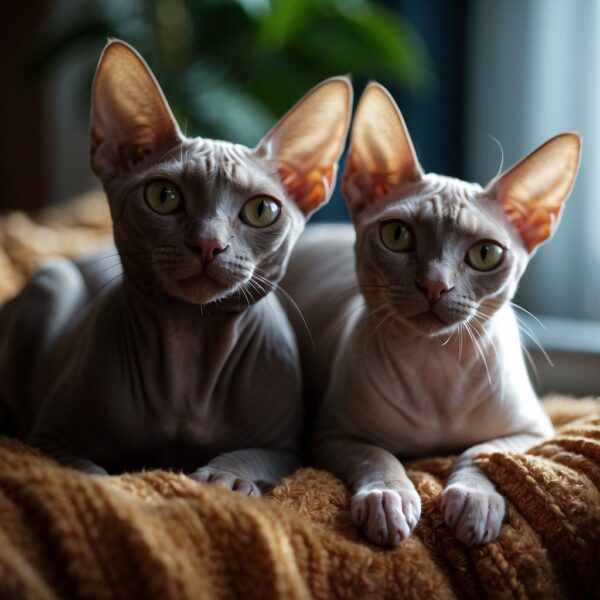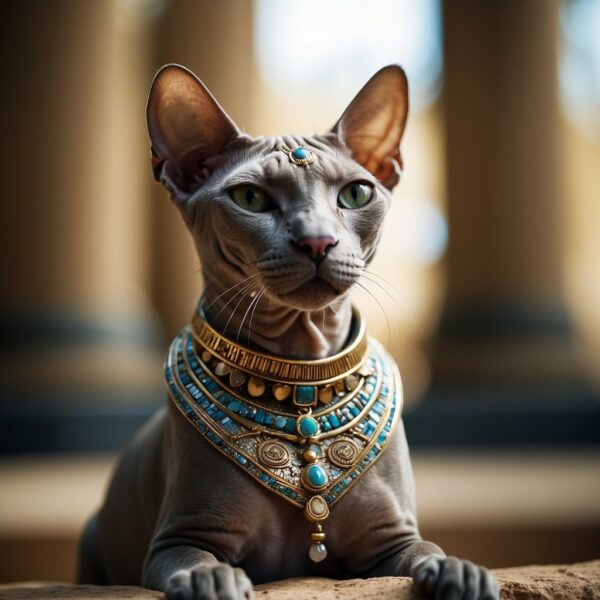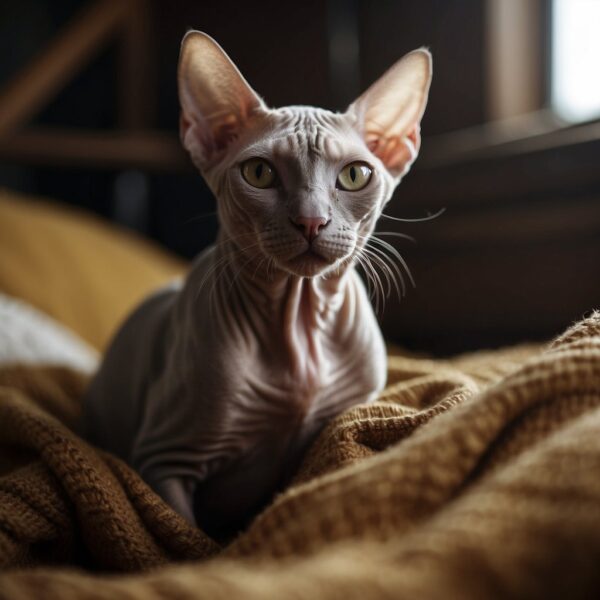
Sphynx Cat: Unique Physical Attributes
The Sphynx cat, with its striking appearance and hairless coat, has intrigued and captivated cat enthusiasts around the world. Known for its prominent ears and wrinkled skin, the Sphynx stands out in the feline world not only for its unique physical attributes but also for its warm and affectionate nature. Due to the lack of a fur coat, this breed is known to be quite heat seeking, often finding warmth by cuddling with their human companions or basking in sunny spots.
Developed through selective breeding in the 1960s from naturally occurring genetic mutations, the Sphynx cat hails from Canada. This breed’s hairlessness is the result of a recessive gene, which means that both parents must pass the gene to their offspring for the trait to be expressed. Their singular appearance, however, is not the breed’s only distinctive feature. The Sphynx is known for its extroverted behavior, showing high levels of energy, intelligence, and a playful spirit which makes them a delightful addition to many families.
Key Takeaways
- The Sphynx cat is distinct for its hairless coat and is affectionate and heat-seeking.
- Originating in Canada, Sphynx cats come from a genetic mutation and were selectively bred in the 1960s.
- They display an outgoing and energetic personality, making them engaging pets.

sphynx cat Origin and History
The Sphynx cat’s unique appearance stems from genetic mutation, and over time, breeders in North America intentionally developed the breed. This process led to official breed recognition.
Genetic Mutation
The Sphynx breed traces its origins to a genetic mutation that resulted in hairless kittens. This mutation is natural and not unique to the Sphynx; similar genetic traits have appeared in various cat populations over time. The contemporary Sphynx cat, however, can be linked to specific hairless kittens born in North America.
Development of the Breed
The specific lineage of the modern Sphynx breed began with a hairless kitten named Prune, born in 1966 to a domestic cat in Toronto, Canada. This kitten’s unique appearance attracted the attention of a Siamese breeder. Recognizing the potential for a new breed, the Canadian hairless, selective breeding programs commenced. The breeding efforts involved outcrossing with traditionally furred cats, including the Siamese, to establish a gene pool that caused the breed to thrive.
Breed Recognition
The distinct look and growing popularity of the Sphynx cat led to its official recognition as a breed. North American and European cat registries began to formally acknowledge the Sphynx in the latter part of the 20th century. With its increasing presence in North America and beyond, the Sphynx has secured its place in the cat-breeding world and continues to be a favorite for those seeking a non-traditional feline companion.
sphynx cat Physical Characteristics
The Sphynx cat, prized for its unique appearance, displays several distinctive traits such as a hairless body, pronounced wrinkles, and large, engaging ears and eyes.
Appearance
The Sphynx is a medium-sized cat with a weight typically less than 12 pounds. However, despite their size, they possess a muscular, dense body that appears powerful and hefty for its size. The overall length from head to the tip of the tail ranges between 13 to 15 inches.
Lack of Fur and Skin
What sets the Sphynx apart from other breeds is its nearly hairless appearance. The coat, where present, feels like peach fuzz. Their wrinkly skin is soft to the touch, which can be likened to suede or chamois leather, and they may come in any coat color including white, black, red, brown, and lilac.
Distinctive Ears and Eyes
A Sphynx’s large ears and lemon-shaped eyes make a striking statement. Their ears are a significant feature, being oversized in proportion to their head, often alert and sensitive to sounds. The eyes are prominent and expressive, contributing to the breed’s characteristic look and adding to their aesthetic appeal.

sphynx cat Personality and Behavior
Sphynx cats are renowned for their distinctive personality traits, marked by a combination of affection, playfulness, and intelligence. They thrive on social interactions, showcasing behaviors that reinforce their sociable nature.
Temperament
The temperament of the Sphynx cat is characteristically affectionate and sociable. They form strong bonds with their guardians and often seek out human attention. Their desire for interaction is paired with a generally friendly disposition towards strangers, making them exceptional companions.
Intelligence and Playfulness
Sphynx cats exhibit high levels of intelligence, often displaying behaviors that indicate a capacity for problem-solving. This intelligence translates into playfulness, with these cats actively seeking out games and engagement. They enjoy interactive toys and puzzles, which provide mental stimulation and fulfill their innate curiosity.
Interactions with Children and Other Pets
Their social nature extends to their interactions with children and other pets. Sphynx cats are typically affectionate with children, demonstrating a gentle and playful behavior that can make them suitable for families. They are also known to coexist well with other pets, often becoming an integral part of a multi-pet household.
Health and Care
Sphynx cats are distinct in their grooming needs and health profile, requiring dedicated attention to maintain their wellbeing. Regular grooming is essential due to their lack of traditional fur, and awareness of breed-specific health issues can ensure proactive care.
Grooming Requirements
Sphynx cats lack the insulating fur that other breeds possess, making them vulnerable to dirt and oil buildup on their skin. They require regular bathing—at least once a week—to prevent the accumulation of oils and to maintain healthy skin. Guadians should use a mild, cat-friendly shampoo during baths. Ears also warrant special attention; they should be checked and cleaned regularly to remove any excess wax or debris, as Sphynx cats produce more earwax due to the lack of hair in their ear canals.
Common Health Issues
Sphynx cats can be predisposed to certain health conditions:
- Hypertrophic cardiomyopathy (HCM): The most common form of heart disease in cats, and should be monitored with regular veterinary check-ups.
- Hereditary myopathy: Affects muscle function.
- Urticaria pigmentosa: A skin condition that can cause crusty sores, and requires medical attention.
- Periodontal disease: As with all cats, dental care is crucial for preventing periodontal issues, necessitating regular tooth brushing and veterinary dental check-ups.
Special Considerations in Care
- Temperature Sensitivity: With no fur coat for insulation, Sphynx cats are more sensitive to cold and can easily become chilled. They often require a warm environment and may benefit from sweaters in cooler weather. Conversely, without fur to shield their skin, they are also at risk for sunburn and should thus be protected from excessive sun exposure.
- Diet: Due to a higher metabolism, they may need more food compared to other breeds, as well as a diet with adequate nutrition to support their energy needs.
- Social Needs: They are known for their extroverted and affectionate nature, necessitating ample social interaction and stimulation to keep them happy and engaged.
Living with a Sphynx
A Sphynx cat requires special attention to their diet and nutrition, maintaining their energy through exercise and play, and ensuring their environment is safe and cat-friendly.
Diet and Nutrition
The cat’s diet should be composed of high-quality food that is appropriate for their age, size, and energy level. They often require more food than the average feline because their higher metabolism helps maintain body heat due to the lack of fur. It is important to monitor their weight closely and adjust their diet accordingly to prevent obesity.
- Meal Frequency: Small, frequent meals can help maintain energy throughout the day.
- Caloric Intake: Increased compared to other breeds due to higher energy expenditure.
Exercise and Play
Sphynx cats possess a high energy level and need regular exercise and playtime to stay healthy and stimulated. They are an active breed that enjoys interactive play with their human companions.
- Activity Level: Highly energetic, requiring ample playtime each day.
- Play Suggestions: Use toys that stimulate them to jump, chase, and pounce to help them expend energy.
Creating a Safe Environment
The environment for a Sphynx cat should be warm and free of hazards since they do not have fur to protect them from the elements or injuries. Maintaining a safe environment is crucial as these cats may seek out warm spaces that could be dangerous.
- Temperature Control: Keep indoor temperatures steady to ensure the cat’s comfort.
- Safety Precautions: Remove hazardous objects they may climb on or ingest.
Sphynx Cat in Popular Culture
The Sphynx cat’s distinctive appearance has captured the imagination of audiences, making it a memorable character in various forms of media from films to television shows.
Notable Sphynx Cats in Media
Film: The Sphynx cat is notably recognized for its role as Mr. Bigglesworth in the “Austin Powers” film series. The transformation of Mr. Bigglesworth from a longhaired breed to a hairless Sphynx cat after being cryogenically frozen with Dr. Evil adds a comedic touch that audiences remember fondly.
Television: Sphynx cats have appeared in iconic television series. For example, in “Friends,” Rachel acquires a Sphynx cat, introducing the breed’s unusual appearance to viewers of the show.
Music Videos: The music industry has also featured this unique breed. The Sphynx cat appears alongside rock musician Ted Nugent, in a music video for his song “Ted Nudegent.” This showcases the sheer versatility of the breed in adapting to various entertainment settings and genres.
Breeds with Shared Qualities
Hairless Breeds
The Sphynx is renowned for its lack of a fur coat, a trait it shares with other hairless breeds like the Donskoy. Both breeds’ hairlessness is the result of a genetic mutation, giving them their distinctive appearance and warm, suede-like skin.
The Devon Rex
Similar to the Sphynx, the Devon Rex has a unique coat, characterized by short, soft, and wavy fur. They do not share the total hairlessness of the Sphynx but possess a similarly engaging and sociable personality.
American Shorthair
While the American Shorthair boasts a fur coat, it shares a robust and playful nature with the Sphynx. They are generally healthy and make for amiable companions like the hairless breeds.
| Breed | Coat Characteristics | Personality |
|---|---|---|
| Sphynx | Hairless, wrinkled skin | Social, affectionate |
| Devon Rex | Short, wavy fur | Personable, lively |
| Donskoy | Hairless | Playful, friendly |
| American Shorthair | Short, dense fur | Good-natured, playful |
These breeds often exhibit a friendly demeanor, making them suitable for families and lively households. Their social inclinations mean they are receptive to interaction and display high levels of affection towards their owners.

Frequently Asked Questions
Sphynx cats are known for their distinctive hairless appearance and affectionate behavior. This section aims to address some of the most common inquiries potential owners and enthusiasts have about the breed.
What contributes to the hairlessness of Sphynx cats?
The hairlessness trait in Sphynx cats is due to a genetic mutation. This gives them their unique appearance, showing little to no fur, although some may have a fine down.
How can one ensure the health and well-being of a Sphynx cat?
To promote the health of a Sphynx cat, maintain regular veterinary check-ups, provide a balanced diet, and keep the cat indoors to protect against temperature extremes and sunburn.
What are the grooming requirements for a Sphynx cat?
Sphynx cats require frequent bathing to remove oil buildup on their skin. They also need regular ear and nail cleaning to prevent infections due to their lack of fur that would typically absorb these oils.
Do Sphynx cats exhibit specific behavioral traits?
Sphynx cats are often social, loving, and smart. They thrive on interaction with humans and other pets and are not known to be inherently aggressive.
Is there a tendency for Sphynx cats to emit an odor, and how can it be managed?
Sphynx cats may develop a noticeable odor if not bathed regularly due to oil and sweat accumulation on their skin. Consistent grooming can effectively manage this issue.
What considerations should be taken into account when thinking of adopting a Sphynx cat?
Prospective Sphynx cat parents should consider the breed’s need for companionship, regular grooming, and potential health issues such as temperature sensitivity. They should also be prepared for the financial commitment to its care.